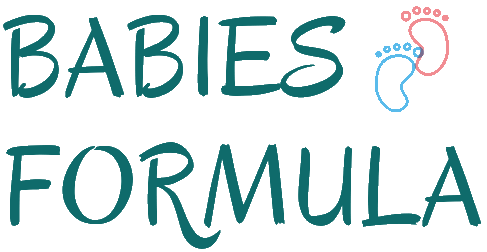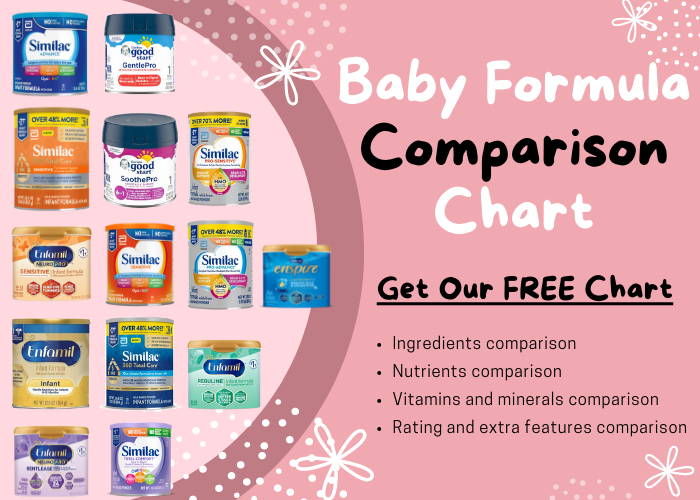You have probably switched to soy formula recently, and were surprised by the color, frequency, or consistency of your baby’s poops. Therefore, you are wondering whether these new poops are normal or not. Well, I will cover all these questions you have about soy formula baby poop, so stay with me.
What Does a Soy Formula Poop Look Like?
Newborn Poop:
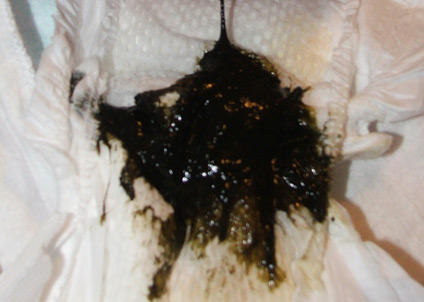
In the first three days, all newborns have a dark green to black, sticky, and tarry-like poop called meconium.
If your newborn passes meconium in his first few days, it means that his bowels are doing their job correctly. After that, the color and consistency will depend on feeding type (breastfeeding or formula-fed).
Soy Formula Baby Poop:

Soy formula poop is often green to dark green, with a bad smell, and a hard/firm consistency like peanut butter. The poop frequency is once to twice a day and sometimes a poop every few days which is normal. The green and dark green colors are due to the high level of iron in soy formulas. Furthermore, the hard consistency is due to palm oil.
The hardening of the poop is due to palm oil existing in soy formulas. During palm oil digestion, the calcium binds with the palmitic acid (free fatty acid) to form an insoluble calcium-palmitate soap that can cause harder stools or constipation.
Note: If the stool is harder than peanut butter and your baby has pain during BMs, your baby could be constipated. Therefore, you should tell your pediatrician.
Similac Soy Isomil will be the right choice for constipated babies because it doesn’t contain palm oil and has prebiotics (food for probiotics). I wrote an article about the best soy formula for each condition if you want to check.
How Often Should a Soy Formula-Fed Baby Poop Per Day?
Every baby is different. Generally, a baby who drinks soy formula stool once to twice a day, whereas others poop one time every few days; it’s totally fine as long as your baby doesn’t struggle when pooping, and he is thriving.
You don’t have to be concerned about how often should a baby poop but how the poop is after passing out. Color and consistency are more important than frequency. However, if your little one doesn’t poop for more than five days, he might be constipated, and you should see the pediatrician.
Soy Formula Poop Smell:
All newborns’ poops are not smelly. While they grow up, their bowels will be colonized with bacteria. Therefore, their poops become smelly. This process is normal as long as your baby is thriving and has a soft stool.
Soy formula-fed babies have smelly poop that will make you run out of the house. It has a pungent odor, sometimes like rotten eggs, sometimes like vinegar, and sometimes will depend on what you LO is eaten.
Sometimes, a very smellier poop may be an indication of the malabsorption of nutrients. However, if your infant’s poop has a normal consistency and color, and he is gaining weight, you don’t have to be concerned. If not, call your pediatrician.
Soy Formula Poop Color:
Does Soy Formula Cause Green, Dark Green Poop?
The green or dark green poop is common for most soy formula-fed babies; the reason is the high level of iron in soy formulas. The green stool can also appear after 4 to 6 months when you introduce solid foods to your baby’s diet, especially green foods. The green or dark green poop is totally fine when your baby is drinking soy formula.
Note The only case where the green poop is a concern; is when the baby is ill or has a fever, then he might have a bacterial infection, and you must see your pediatrician.
Orange, Yellow, and Brown Poop:
Orange, yellow, or brown poops are normal and mean that your little one is doing great with this soy formula brand. If you see a range of these colors in your baby’s stools, that’s because of pigment picked up during digestion.
Black, or Red Poop:
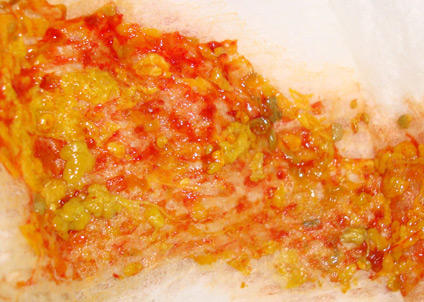
A black and red poop during soy formula-fed may be a sign of blood in the poop; it becomes black after moving in the bowels. Bloody poop can be a result of soy protein allergy or digestive problems. In this case, you should consult your pediatrician immediately.
In the case of soy protein allergy, changing to an amino acid-based formula (Neocate or Elecare) will be a good decision. In this formula, the protein is broken into blocks (amino acids), so the immune system can’t detect it.
Regarding digestive problems, you should opt for another soy formula. Gerber Good Start Soy Plant-Based will be a good choice; it is partially hydrolyzed, which means the soy protein is broken into large pieces for easy digestion.
If you are using a hypoallergenic formula; you may want to see what does a hypoallergenic formula poop looks like?
White Poop:
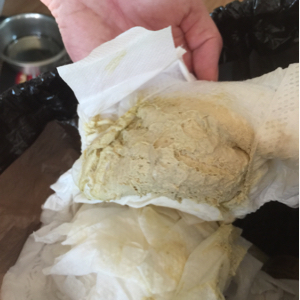
White or gray baby poop is a warning sign that your baby has a problem digesting food. You should call your pediatrician immediately.
Soy Formula Poop Consistency:
Does Soy Formula Make Babies Poop Hard?
Yes, soy formula makes the poop little hard and has a consistency like peanut butter. That’s because palm oil exists in most soy formulas. The insoluble calcium-palmitate soap produced during palm oil digestion what makes the stool hard.
If you notice that the stools are harder than peanut butter or look like a pebble, then your kiddo could be constipated. One or two pebbly stools are fine. However, three pebbly diapers or more is a concern, and you should consult your pediatrician.

Solutions:
To loosen stools, Tracie Newman, MD from news.sanfordhealth.org, recommends giving apple, prune, or pear juice twice daily for babies older than 1 to 2 months. The sugar in the juice won’t be well digested, and this moves the fluid to the colon to help loosen poops. Regarding juice amount, Tracie Newman, MD, advises giving 1 ounce of juice for each month of life until four months (ex: 2 ounces for a 2-month-old baby).
For older babies, strained or pureed foods with high levels of fiber will make the poops loosen. Foods that include peaches, pears, plums, prunes, peas, cereals, apricots, beans, or spinach are high in fiber.
While other pediatricians recommend adding an extra ½ – 1 ounce of water to the baby’s bottle to loosen stools or giving him a tablespoon of Karo syrup twice a day, that’s working well for many parents.
Runny or Watery Poop:

A runny or watery poop that sometimes comes out of the diapers could be a sign f diarrhea. It has a yellow, green, or brown color and is runny, it’s a concern for babies who are three months old or younger and have diarrhea for more than a day or two or have two to three runny explosive stools a day.
If so, you must call your pediatrician for consultation. Infection or allergy can cause diarrhea. And can lead to dehydration if not treated quickly.
Solid Poop:

Solid poops generally appear when you introduce solid foods; they are tended to be brown or dark brown and thicker than peanut butter. Also, they are smelly. It is a normal stool, and there is nothing to worry about.
Mucus in Baby Poop:
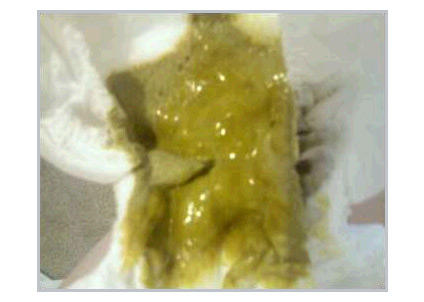
For newborns, mucus in poops is normal as they pass meconium stools. The mucus-like stools can also show up when your baby is drooling from teething.
However, it’s a warning sign when your baby is older than 3 – 4 days and not drooling; then, you should call your pediatrician immediately because it can be an infection or allergy.
Undigested food in baby poop:
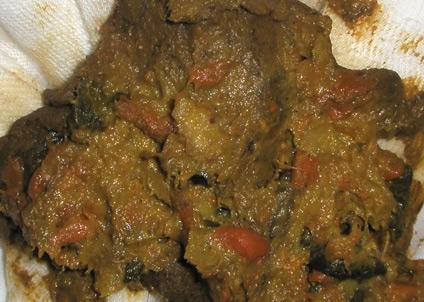
When introducing solid foods, certain foods are traveling so quickly through the bowels or may not be well-digested; another probable reason is that babies swallow foods before they chew them well. As a result, you will see chunks or a surprising color like red, orange, or dark blue depending on the food type they eat.
If your kiddo stools undigested foods several times, then you need to consult your pediatrician.
Soy Formula Brands Poop:
Enfamil ProSobee Poop :
Most babies who are on Enfamil ProSobee have a hard 1 to 2 poopy diapers a day. Other parents said that when they switched to ProSobee, their babies become constipated, so they add ½ – 1 ounce of water to the bottle, which helps loosen the stool.
I have written a full guide about The Best Soy-Based Formulas in 2022 + (Cheap)!! if you want to choose the right soy-based formula for your little one.
Earth’s Best Soy Formula:
According to parents’ reviews about earth’s best soy formula poop. Most babies on earth’s best soy suffer when passing stools. Palm oil is the primary reason.
Similac Soy Isomil Poop:
Most babies who drink Similac Soy Isomil have pasty, green to dark green, and very smelly poops. Don’t panic; it’s very normal as long as the baby passes urine 6-8 per day. Those babies, most of them have a few bowel movements in the first. After that, the poops’ frequency is increased.
Related: Top 3 Generic Similac Soy Isomil Formula
Puramino Formula Poop:
Babies on Puramino formula have loose, dark green stools that have a consistency of cake batter. The dark green stools it’s fine except if your baby is ill or has a fever or diarrhea, then you must call your pediatrician.
Soy Formula Poop vs. Breastfed Poop:
Breastfed baby poop tends to be runny enough to resemble diarrhea, pasty, seedy, and has a mustard yellow, brown or green color. Moreover, it has a sweet odor. Breastfed babies have two bowel movements in a day during the first three days. Then they continue passing about 8 – 12 stools a day or every time they eat. The stool frequency decrease while growing up to 3-4 poops a day. After six weeks, babies tend to pass fewer poops, maybe even one poop in a week.
Contrariwise to soy formula baby poop, it’s firmer and smellier than breastfed baby poop. It has a green to dark green color and butter peanut-like consistency.
Soy formula baby poop frequency depends on one baby to another, from formula to another. In general, it’s less frequent than breastfed baby poop. Most babies on soy formula have one to two BMs a day, while others have one dirty diaper every 2 or 3 days, it’s totally fine as long as the stool is soft and the baby doesn’t strain while passing the stools.
If you’re combo feeding, check this article about What Does a Combo-Fed Baby Poop Looks Like? to get an idea about normal color, consistency, frequency, and smell, among with many information and warning signs to worry about.
Warning signs:
You must call your pediatrician immediately if you notice these signs:
- Your baby doesn’t poop for more than 5 days and strains for more than 10 minutes without pooping, or has a pebble-like stool (constipation);
- White poop (digestion problems);
- Red blood, or mucus in the stool (infection or allergy);
- Runny stool (it could be diarrhea)
Conclusion:
Baby poops are a concern for many parents, especially if they see a surprising color, consistency, or frequency when they switched to soy formula. The most important thing to notice is consistency and color. The frequency is less important as long as the baby doesn’t strain when pooping. Moreover, soy formula makes stool frequency less than breastfed baby poop; therefore, don’t panic if you notice that your little one is not pooping for 3 or 4 days.
Three colors are warning signs; red, black, and white. Except that, all colors are normal. Moreover, Mucus or blood in stools is a red flag, as well as runny poop. These signs need a consultation from your PD.
If you still have questions feel free to ask in the comments.
Resources:
https://www.healthline.com/health/parenting/baby-poop-color#frequency
Images Sources :
